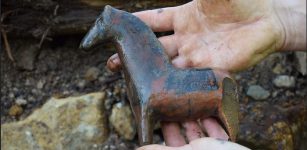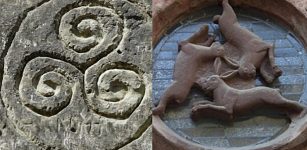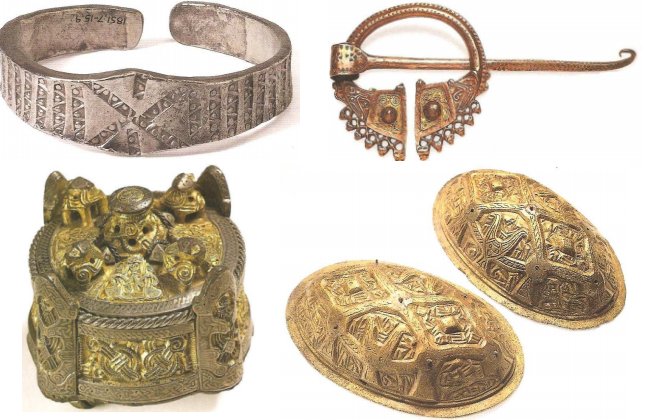Viking Fashion: Men And Women Were Vain And Very Clean During The Viking Age
Ellen Lloyd - AncientPages.com - There are many myths and misconceptions about the Vikings. One is that they were dirty and did not pay attention to their appearance. Few things can be further from the truth. Archaeological discoveries reveal that Vikings were cleaner than most and rather vain.
Credit: IMDb - Fair use
Personal Hygiene Was Very Important To Vikings
Scientists have discovered tweezers, combs, razors, nail cleaners, ear cleaners, and toothpicks inside Viking tombs. These artifacts show that people of the Viking Age took great care in personal grooming.
In his chronicle from 1220, John of Wallingford described the Vikings as well-groomed heartbreakers.
"They had also conquered, or planned to conquer, all the country's best cities and caused many hardships for the country's original citizens, for they were - according to their country's customs - in the habit of combing their hair every day, to bathe every Saturday, to change their clothes frequently and to draw attention to themselves by means of many such frivolous whims.
In this way, they sieged the married women's virtue and persuaded the daughters of even noble men to become their mistresses," Wallingford wrote.
Viking combs. Credit: Mariana Muñoz-Rodriguez
Bone pins, delicately carved from animal bone, were used to fasten clothing or as hair decorations. Vikings paid plenty of attention to their beards and hair. Bones and antlers were carved to create hair combs, which became prized possessions. Hair had to be styled right, and the beard could be short or long, but it was always well-groomed. Archaeologists have confirmed that several Viking combs were produced in Hedeby, a major trading center during the Viking Age.
Viking women, in most cases, had long hair tied into a knot on the back of the head. The knot was often decorated with colorful tape braided into the hair. The women also wore a bonnet or a scarf around their heads.
What Viking outfits looked like remains a mystery because knowledge of Viking fashion is based on fragments of clothes discovered in ancient tombs. Unfortunately, most Viking clothes have rotted away and disappeared when archaeologists excavated their tombs.
It is also important to remember that people living during the Viking Age never spoke of themselves as Vikings. To understand why ancient Scandinavians did not refer to themselves as Vikings, one must remember the meaning of the word Viking. In Old Norse, an old Scandinavian language, the word appears as "vikingr", which designates a person, while "viking" designates a practice. Therefore, it is better to say there are some things we do know about Viking Age fashion.
Our knowledge about Viking fashion is based on artifacts discovered in ancient tombs. National Museum of Denmark
Scientists have successfully produced clothes our ancestors wore by analyzing archaeological finds of textile tools, textiles, skins, and fibers from graves and settlements. For example, Viking Age women usually wore long dresses or skirts that went down to the feet. These dresses were held together with a strap over each shoulder. Men wore the same materials as the women. The inner layer usually consisted of a linen kirtle—a long shirt the men pulled over their heads. On the outside, the typical Viking man wore a wool coat.
Reconstructed woman's and man's costumes from Well-dressed in the Viking Age. Credit: Charlotte Rimstad
Like today's men, Viking men wore trousers. These could be either short or long, and they were usually sewn in the style of pantaloons. These trousers only reached down to the men's knees.
Vikings Loved Colors - Especially Blue And Red
Men usually wore a hat, whereas women could choose between a small hat and a scarf. What has also been discovered is that Vikings loved various colors. The most popular ones were blue and red.
Vikings were also familiar with luxuries such as silk and sewn-on ribbons with silver and golden threads. However, only a few elite members could wear these exclusive fabrics, which were imported worldwide.
Ancient Viking jewelry. Credit: Fitzhugh, William W. - Vikings: The North Atlantic Saga
Astonishing Norse jewelry discovered in hoards and burial sites reveals that Vikings were highly skilled craftsmen. Viking jewelry was beautifully made, and it's still reproduced today.
Vikings certainly paid great attention to beautiful garments and accessories. Based on all these archaeological findings, it's fair to say that Vikings were by no means badly dressed and dirty.
Written by Ellen Lloyd - AncientPages.com
Copyright © AncientPages.com All rights reserved. This material may not be published, broadcast, rewritten or redistributed in whole or part without the express written permission of AncientPages.com
More From Ancient Pages
-
 Horses In Florida Did Not Travel Far Distances – New Study Suggests
Archaeology | Jan 3, 2019
Horses In Florida Did Not Travel Far Distances – New Study Suggests
Archaeology | Jan 3, 2019 -
 Surprising Mask Of A Human Face Found On Cistern Wall In The Ancient City Of Ptolemais
Archaeology | Jan 17, 2025
Surprising Mask Of A Human Face Found On Cistern Wall In The Ancient City Of Ptolemais
Archaeology | Jan 17, 2025 -
 World’s Oldest Dala Horse Discovered In Sweden
Archaeology | Jul 18, 2020
World’s Oldest Dala Horse Discovered In Sweden
Archaeology | Jul 18, 2020 -
 Rare Roman Mosaic Depicting The Adventures Of Greek Hero Achilles Discovered In Rutland, UK
Archaeology | Dec 4, 2021
Rare Roman Mosaic Depicting The Adventures Of Greek Hero Achilles Discovered In Rutland, UK
Archaeology | Dec 4, 2021 -
 Marble Head Of Roman Emperor Augustus Unearthed In Isernia, Italy
Archaeology | May 7, 2021
Marble Head Of Roman Emperor Augustus Unearthed In Isernia, Italy
Archaeology | May 7, 2021 -
 Obsidian Blades Reveals Dynamic Neolithic Social Networks – New Analysis
Archaeology | Oct 18, 2022
Obsidian Blades Reveals Dynamic Neolithic Social Networks – New Analysis
Archaeology | Oct 18, 2022 -
 15,000-Year-Old Petroglyphs Discovered In The Gobi Desert May Be Evidence Ancient Turks Visited Mongolia – Expert Says
Archaeology | Apr 5, 2022
15,000-Year-Old Petroglyphs Discovered In The Gobi Desert May Be Evidence Ancient Turks Visited Mongolia – Expert Says
Archaeology | Apr 5, 2022 -
 2,550 Submerged Wooden Objects Recovered From The Templo Mayor Of Tenochtitlan
Archaeology | Jun 25, 2022
2,550 Submerged Wooden Objects Recovered From The Templo Mayor Of Tenochtitlan
Archaeology | Jun 25, 2022 -
 Rare Discovery: 530 Knuckle Bones ‘Astragali’ For Gaming And Divination Unearthed In Ancient City Of Maresha
Archaeology | Aug 16, 2022
Rare Discovery: 530 Knuckle Bones ‘Astragali’ For Gaming And Divination Unearthed In Ancient City Of Maresha
Archaeology | Aug 16, 2022 -
 Triskelion – Millennia Old Traditional Symbol Used In Many Cultures Around The World
Ancient Symbols | Dec 13, 2018
Triskelion – Millennia Old Traditional Symbol Used In Many Cultures Around The World
Ancient Symbols | Dec 13, 2018 -
 Varahamihira: Indian Sage And One Of The Greatest Minds Of All Time
Featured Stories | Sep 13, 2016
Varahamihira: Indian Sage And One Of The Greatest Minds Of All Time
Featured Stories | Sep 13, 2016 -
 Dura-Europos Roman Shield Created With Ancient Painting Techniques On Wood
Archaeology | Nov 9, 2015
Dura-Europos Roman Shield Created With Ancient Painting Techniques On Wood
Archaeology | Nov 9, 2015 -
 Mystery Of The Ancient Sitovo Inscription: Undeciphered Script Or Just A Natural Rock Formation?
Featured Stories | Apr 17, 2016
Mystery Of The Ancient Sitovo Inscription: Undeciphered Script Or Just A Natural Rock Formation?
Featured Stories | Apr 17, 2016 -
 Nine Great Wall Beacon Towers Discovered In China’s Inner Mongolia
Archaeology | Apr 21, 2020
Nine Great Wall Beacon Towers Discovered In China’s Inner Mongolia
Archaeology | Apr 21, 2020 -
 Undiscovered Neanderthal Artifacts From The Ice Age Are Submerged Below The Waves Of The English Channel
Archaeology | Nov 23, 2022
Undiscovered Neanderthal Artifacts From The Ice Age Are Submerged Below The Waves Of The English Channel
Archaeology | Nov 23, 2022 -
 Ancient Humans: Clarifying The Co-Existence Between Modern Humans And Neanderthals
Archaeology | Oct 13, 2022
Ancient Humans: Clarifying The Co-Existence Between Modern Humans And Neanderthals
Archaeology | Oct 13, 2022 -
 Sculptures Of Kybele, Athena, Hekate, Apollo Unearthed At Hellenistic Site Of Pisidia Antiocheia, Turkey
Archaeology | Oct 15, 2017
Sculptures Of Kybele, Athena, Hekate, Apollo Unearthed At Hellenistic Site Of Pisidia Antiocheia, Turkey
Archaeology | Oct 15, 2017 -
 Pompey The Great: One Of Roman Empire’s Most Successful Military Commanders
Featured Stories | Jun 14, 2019
Pompey The Great: One Of Roman Empire’s Most Successful Military Commanders
Featured Stories | Jun 14, 2019 -
 Fall Equinox Explains Unusual Alignment Of Egypt’s Great Pyramids – Engineer Says
Archaeology | Feb 26, 2018
Fall Equinox Explains Unusual Alignment Of Egypt’s Great Pyramids – Engineer Says
Archaeology | Feb 26, 2018 -
 Berserkers In Mesopotamia, Europe And India: Old Tradition Of Mad Fighting Dates Back At Least 3000 BC
Ancient Traditions And Customs | Jun 6, 2017
Berserkers In Mesopotamia, Europe And India: Old Tradition Of Mad Fighting Dates Back At Least 3000 BC
Ancient Traditions And Customs | Jun 6, 2017





